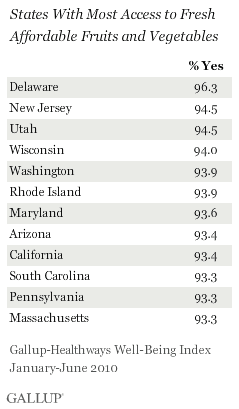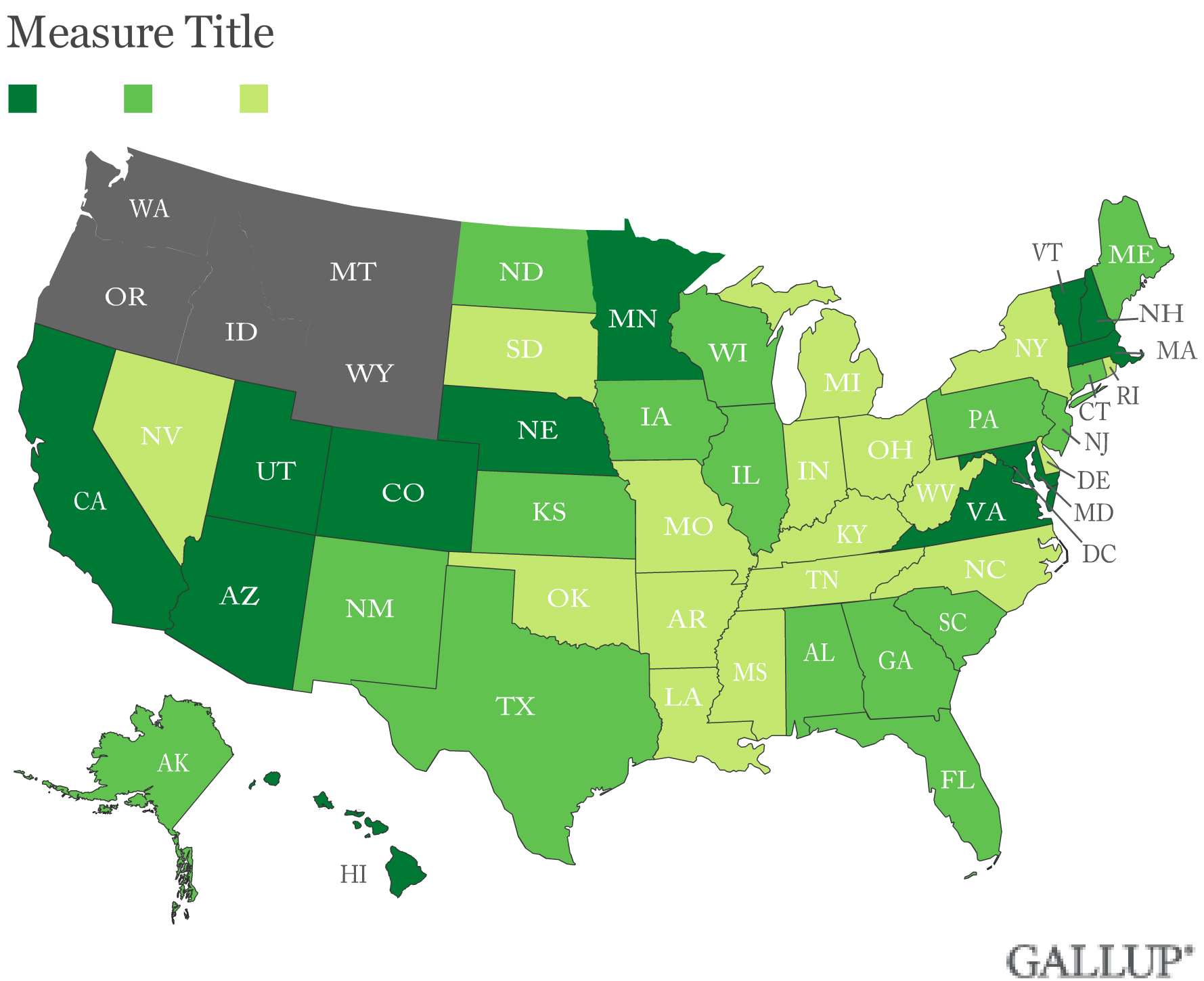WASHINGTON, D.C. -- On the heels of the news that Americans aren't consuming as many fruits and vegetables as recommended, an analysis of Gallup-Healthways Well-Being Index data from 2010 suggests access may not be the problem. Nationwide, 92% of Americans report easy access to affordable fresh produce where they live, as do at least 8 in 10 residents in all states but Alaska.
 |
 |
The Gallup-Healthways Well-Being Index asks Americans each day about their ease of access to affordable fresh fruits and vegetables in their community as well as on how many days in the past week they consumed five or more servings of fruits and vegetables. This analysis is based on 176,544 interviews conducted with adults nationwide between January-June 2010.
Nationwide, less than half of Americans (46.6%) report eating five or more servings of fruits and vegetables on five or more days per week, but 32.7% do so two to four days per week and 19.4% do so one or fewer days per week. Those who say they do not have easy access to fresh produce consume less fruits and vegetables than those who do.
The findings make clear the gravity of the challenge for those who are encouraging Americans to eat more fruits and vegetables. Even among Americans with easy access to fresh produce, more than half are not consuming fruits and vegetables on a frequent basis on five or more days per week.
The government's Healthy People 2010 initiative in 2000 set out to get 75% of Americans to eat two servings of fruit and 50% to eat three servings of vegetables daily by 2010. A CDC report released last week, based on data collected in 2009, finds 32.5% hitting the target for fruits and 26.3% for vegetables, and consumption actually down in the past decade. Gallup also previously reported a decline in fruit and vegetable consumption from 2008 to 2009.
The Gallup-Healthways question differs from the CDC question in that it gauges the number of days per week Americans consume five servings or more of fruits and vegetables rather than how many times per day they eat these foods. The CDC used to recommend five or more servings daily and now encourages consuming "generous amounts" of fruits and vegetables customized to individuals' age, sex, and activity level. It contends doing so reduces risk of chronic diseases such as stroke, type 2 diabetes, some types of cancer, and perhaps heart disease.
The Gallup-Healthways data suggest that making it easier to get affordable fruits and vegetables may not be enough to significantly increase consumption. Most states do a good job of providing easy access to fresh produce the vast majority of their residents. Future analyses will explore access within cities and specific subgroups.

Implications
While the vast majority of Americans nationwide and in most states report easy access to affordable fresh fruits and vegetables, more than half of Americans are not yet consuming fruits and vegetables on a frequent basis on five or more days per week. While easy access to fresh produce does appear to be related to greater consumption at the national level, policymakers and community leaders should also recognize that even 100% access may not get Americans to eat as many fruits and vegetables as they should. While the health benefits of better eating are widely known, it is clear that influencing something as personal as what one eats on a daily basis is no easy task.
About the Gallup-Healthways Well-Being Index
The Gallup-Healthways Well-Being Index tracks U.S. well-being and provides best-in-class solutions for a healthier world. To learn more, please visit well-beingindex.com.
Survey Methods
Results are based on telephone interviews conducted as part of the Gallup-Healthways Well-Being Index Jan. 2-June 30, 2010, with a random sample of 176,544 adults, aged 18 and older, living in all 50 U.S. states and the District of Columbia, selected using random-digit-dial sampling.
The margin of sampling error for most states is ±1 to ±2 percentage points, but is as high as ±4 percentage points for smaller states such as Wyoming, North Dakota, South Dakota, Delaware, and Hawaii.
Interviews are conducted with respondents on landline telephones and cellular phones, with interviews conducted in Spanish for respondents who are primarily Spanish-speaking. Each daily sample includes a minimum quota of 150 cell phone respondents and 850 landline respondents, with additional minimum quotas among landline respondents for gender within region. Landline respondents are chosen at random within each household on the basis of which member had the most recent birthday.
Samples are weighted by gender, age, race, Hispanic ethnicity, education, region, adults in the household, cell phone-only status, cell phone-mostly status, and phone lines. Demographic weighting targets are based on the March 2009 Current Population Survey figures for the aged 18 and older non-institutionalized population living in U.S. telephone households. All reported margins of sampling error include the computed design effects for weighting and sample design.
In addition to sampling error, question wording and practical difficulties in conducting surveys can introduce error or bias into the findings of public opinion polls.
For more details on Gallup's polling methodology, visit https://www.gallup.com/.

